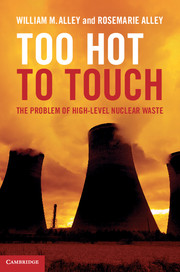Book contents
- Frontmatter
- Contents
- Acknowledgments
- List of units
- List of abbreviations
- Introduction
- Part I The problem
- 1 The awakening
- 2 Brainstorming
- 3 The ocean as a dumping ground
- 4 Radioactivity and atomic energy
- 5 The Cold War legacy
- 6 The peaceful atom and its wastes
- 7 Recycling
- 8 Dry cask storage
- 9 Interim storage
- 10 A can of worms
- 11 WIPP
- Part II The mountain
- Part III No solution in sight
- Appendix Discussion questions
- References
- Index
1 - The awakening
from Part I - The problem
Published online by Cambridge University Press: 05 February 2013
- Frontmatter
- Contents
- Acknowledgments
- List of units
- List of abbreviations
- Introduction
- Part I The problem
- 1 The awakening
- 2 Brainstorming
- 3 The ocean as a dumping ground
- 4 Radioactivity and atomic energy
- 5 The Cold War legacy
- 6 The peaceful atom and its wastes
- 7 Recycling
- 8 Dry cask storage
- 9 Interim storage
- 10 A can of worms
- 11 WIPP
- Part II The mountain
- Part III No solution in sight
- Appendix Discussion questions
- References
- Index
Summary
I can't think about that right now…I’ll think about that tomorrow.
Scarlett O’Hara, Gone with the WindIn January 1949, the Atomic Energy Commission (AEC) held a seminar on radioactive waste. In his opening remarks, AEC Chairman David Lilienthal cast the problem of waste disposal as part of “learning to live with radiation.” According to Lilienthal, this learning curve was the same as how we humans learn to live with anything else unfamiliar. The Chairman of the AEC acknowledged that radioactive wastes could become “a subject of emotion and hysteria and fear…[but] we do not believe those fears are justified provided technology applies itself to eliminating the troubles.” The previous year, Robert Oppenheimer, Chairman of the AEC's General Advisory Committee, had dismissed the waste problem as “unimportant.”
In spite of these pronouncements, dealing with radioactive waste gained greater urgency upon passage of the Atomic Energy Act of 1954, making possible the widespread use of nuclear energy for civilian purposes. As such, the nuclear industry would now be close to major cities and towns. And dilution was not the solution. Given the anticipated size of the US nuclear industry by the year 2000, it would require a volume equal to about five percent of the world’s oceans to dilute the dangerous waste to recommended safe levels. This exceeded the volume of freshwater stored worldwide in lakes, rivers, groundwater, glaciers, and polar ice caps.
- Type
- Chapter
- Information
- Too Hot to TouchThe Problem of High-Level Nuclear Waste, pp. 3 - 20Publisher: Cambridge University PressPrint publication year: 2012



